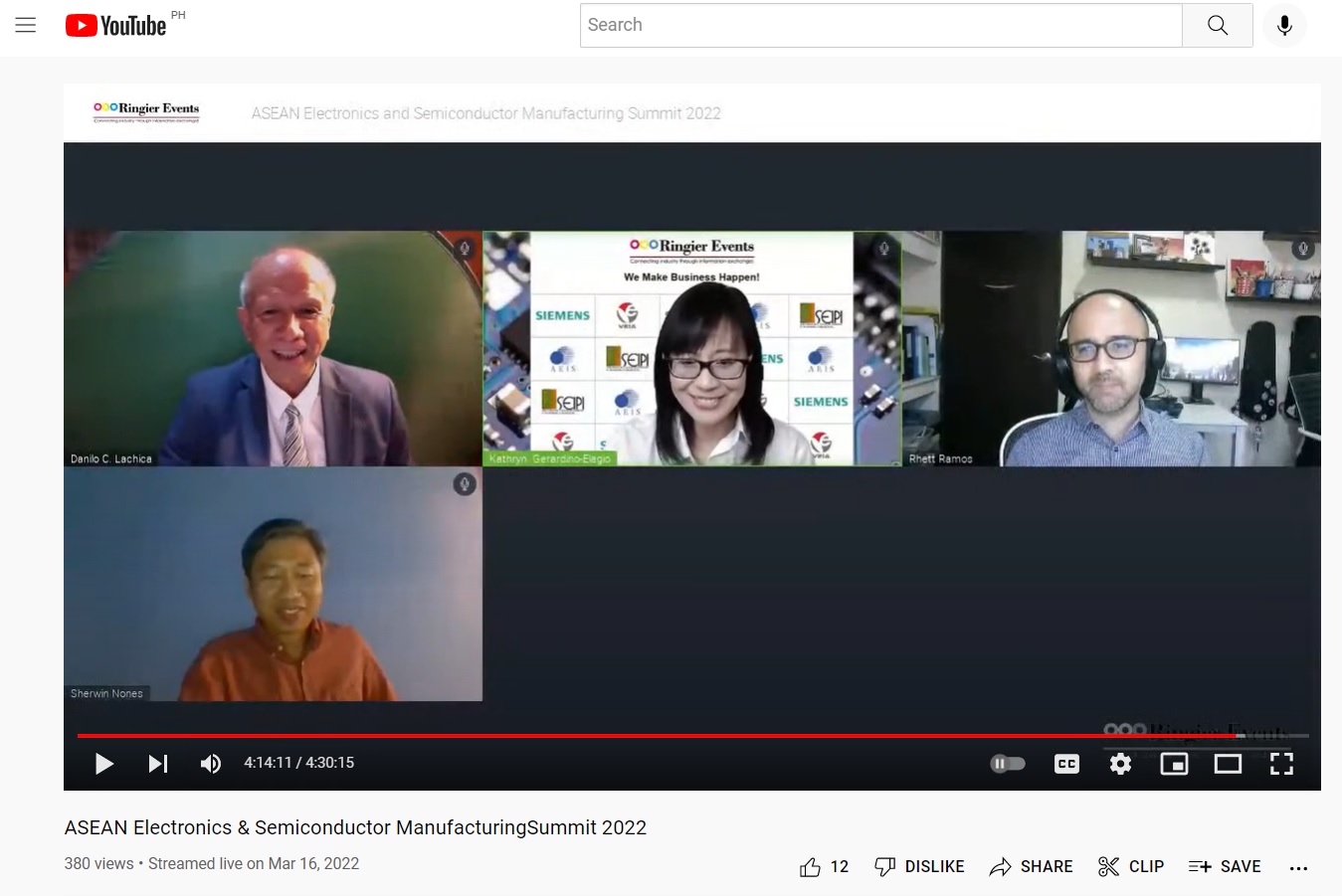By: Kathryn Gerardino-Elagio

In today's dynamic business scenario, the organisations that truly stand out from the pack all have one common factor: they all embrace innovation. Hence manufacturing and innovation go together, enabling the organisation to grow consistently, stay relevant, and be a differentiator to deliver value to its customers.
International Metalworking News for Asia (IMNA) conducted an online panel discussion during the recent ASEAN Electronics and Semiconductor Manufacturing Summit 2022, titled: Digital Transformation, Smart Manufacturing, wherein Dr. Danilo C. Lachica, President of Semiconductor and Electronics Industries in the Philippines Foundation, Inc. (SEIPI), Mr. Rhett Ramos, Director of Asia IT and Smart Manufacturing Director, Allegro MicroSystems, and Mr. Sherwin C. Nones, Head of Strategic Planning and Marketing from Integrated Micro-Electronics Inc. (IMI Global), answered two of the most sought after questions from the attendees. Below are excerpts from the discussion.

IMNA: What are some specific smart solutions can you share that can assist manufacturers in adopting to the evolving industry needs?
Mr. Ramos: The smart solution that we want to share here is the investment in IoT solutions. IoT has been a buzzword for the past six to seven years. As a subset of Industry 4.0, everything is connected. There are sensors in the equipment that will tell you what’s going on. You can set the equipment based on certain conditions or even manually do it.
Being in the semiconductor industry, we have a consortium worldwide that adopts IoT. We have protocols that allows us to plug and play an equipment. The equipment tells us if something goes wrong. And that really allows us to adopt smart manufacturing much faster. This is something I'm hoping that many people in the industry can implement more of those standards, so that they can get faster adoption on the smart manufacturing side.
Dr. Lachica: In terms of a practical example, I will break it down in three segments. First, I will start with industry needs and then go to smart solutions, and then to assisting manufacturers. Let's take the case of the Covid19 pandemic, the rest of the world had to shut down factories but we can't shut down forever. So, we had to figure out a way how to be able to resume production without compromising the safety of the employees and the society at large.
Through innovation and being responsive to the needs of society, we come out with smart solutions. What do I mean by smart solutions? Examples would be like, you know from nothing all of a sudden, people are developing the capability to do respirators, do contactless temperature checks, digital and contactless medical examinations. Those are actually the smart solutions, which eventually address not only the manufacturer's needs but the needs of the society at large. Those are practical examples. But now I should expand it because of the nature of our industry. We are unique in the sense that we're both users of the technologies as well. Suppliers of the hardware are in a unique position that's why this echoes according to the specialities and the nature of our industry.
Mr. Nones: There are so many things every company must take into consideration with the pandemic. One of which would be the areas in making sure that employees are safe. There was a lot of work done behind those. We made sure that we were able to monitor the employees remotely. In IMI, we built a lot of systems just for that. And just over the past couple of years, we were able to really beef up our traceability, not just on the component side but to everything else even in the supply chain from end to end. In fact, what is really a standout today, at least for us, is that we were able to define where smart manufacturing is in terms of our long-term plans. Smart manufacturing automation would generally give us three things: save costs, increase revenue or profits, and create value. But now there is a fourth stream and this is actually the umbrella that encompasses all of these, and this is the road towards sustainability.
Every year, we have customers who are increasingly asking us about this and there are more customers doing sustainability audits and asking us what is our net zero roadmap. It pays to be able to understand where this smart manufacturing is, and I realised over this past couple of years that when you actually put some processes in the Cloud when you automate things, you actually reduce carbon emissions and these are some of the things that will benefit you aside from saving costs and increasing revenue and creating value. When you do smart manufacturing, that gives us a better perspective of where things should be. And right now, we are in the process of really firming up our net zero roadmap and that includes of course our digitalisation roadmap as well.
IMNA: What role will each of your respective associations/companies play in making manufacturing industries more efficient?
Mr. Ramos: Our role is to spearhead and push our members to move into the direction of smart manufacturing. Sadly, a lot of our members are still in Industry 2.0 and so it's going to be a big jump for them. But then it’s our role to understand what are those gaps, and how can we help them adopt. So that it won't be a big obstacle for them to go from Industry 2.0 to a little bit of Industry 4.0. I believe that through industrial transformation, the Philippines can transition to the fourth industrial revolution with adequate understanding.
Dr. Lachica: My role as the head of the association is to be the enabler and the facilitator. I need to make sure that the road map is moving that we're making progress. We are the leading organisation in the Philippines this year for practicing Industry 4.0, and we're not going to keep it to ourselves. We're going to share it with the rest of the other industries in our country. So that they can learn from our experience and be motivated to get up and accelerate their journey towards industrial revolution.
Mr. Nones: The goal is to figure out where is the need for more efficiency and address that; not just for us in the Philippines but on a global scale. For IMI, I think our role here is for us to be a catalyst for our customers and suppliers in achieving certain levels in smart manufacturing and also in sustainability, that is for us is our ultimate goal. Of course, we will continuously align ourselves with the industry working with the government and a lot of universities, not just in the Philippines but in other countries.














